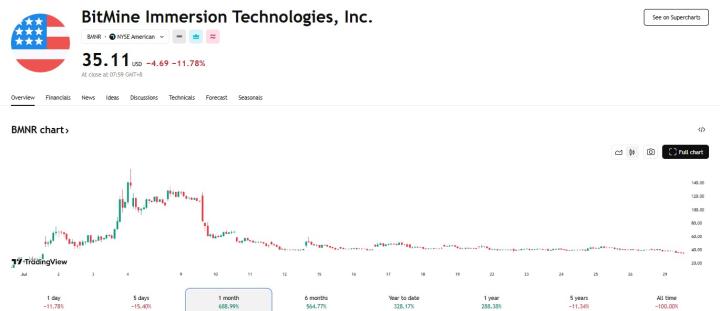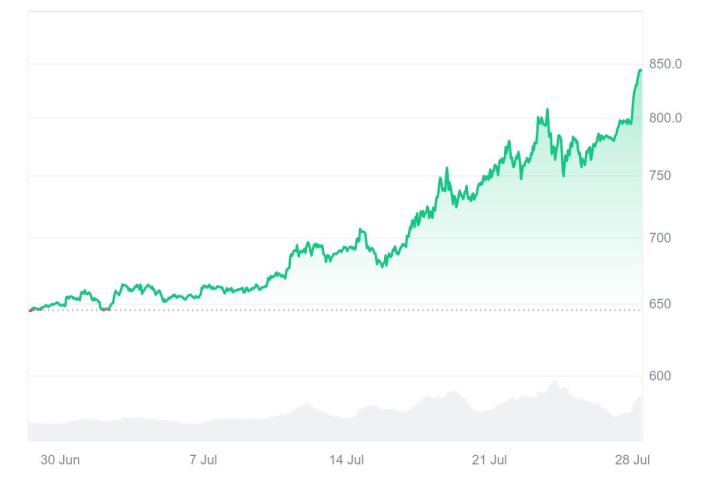The crypto market is witnessing a groundbreaking new game - the Ethereum treasury race.
With new institutional capital operation models represented by BitMine Immersion Technologies (BMNR) and SharpLink Gaming (SBET), Wall Street tools are accelerating ETH accumulation, injecting powerful momentum into the market while triggering important reflections on token economics, market capitalization management, and risk transfer. This experiment deeply combining digital assets and financial engineering has begun to reshape market logic and ecosystem landscape.
Market Volatility: BMNR's Plunge Reveals Wall Street Crypto Capital Game Rules
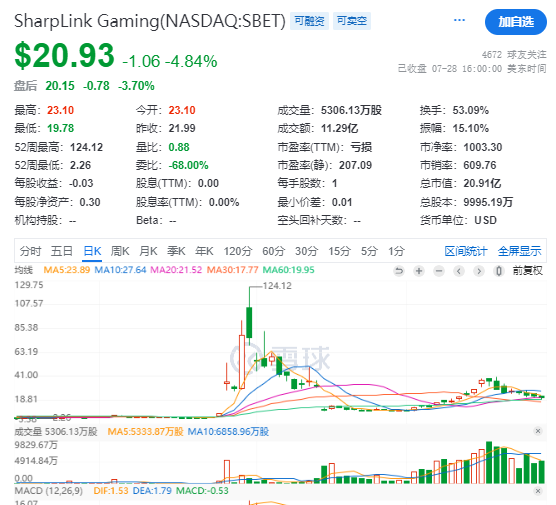
SBET's stock price has dropped nearly 40% for 7 consecutive trading days
A notice in the US stock market last week drew close attention from the crypto market: BMNR, the current leader in the Ethereum treasury race, experienced a significant stock price decline.

A deeper analysis revealed that this is directly related to token unlocking rules for early investors. Previous investors and advisors obtained large amounts of shares at extremely low costs of $4.5, $5.4, and $10 per share, while BMNR's current stock price remains around $35 despite adjustments. This means that even after this adjustment, the stock price is still significantly higher than early investors' entry costs.
As lock-up period constraints disappear, the massive arbitrage space naturally drives these investors to conduct massive selling operations. This unlocking selling pressure caused by equity placement mechanisms, unrelated to the company's fundamentals, is purely an arbitrage behavior based on time and price differences at the capital level, vividly illustrating potential short-term violent fluctuations when introducing traditional Wall Street capital operation logic into crypto asset accumulation.
Although BMNR currently leads with a holding of 566,800 ETH valued at $2.13 billion, its stock price performance is not entirely synchronized with ETH asset reserve trends, highlighting the market's complexity under such structures.
Meanwhile, another participant SBET's operational model has also sparked in-depth market discussion. According to market observations and analyst assessments, SBET seems to follow a strategy cycle considered controversial by some crypto investors: continuously issuing stocks to the open market to obtain incremental funds, then efficiently allocating raised capital to continuously purchase and accumulate Ethereum (ETH) assets.
This approach is vividly described by some market participants as "using US stock investors' funds to generate crypto prosperity". Its essence is utilizing the financing convenience of a compliant open market to provide funding support for crypto assets.
This model, especially within an operational framework centered on ETH, has led some market observers to compare SBET to a "MicroStrategy in the Ethereum domain" - the latter being famous for large-scale Bitcoin accumulation through continuous bond issuance or financing.
Facing Challengers: SharpLink Gaming and ConsenSys' Radical Layout
In this institutional fund race, SharpLink Gaming (SBET) has drawn strong market attention with its rapid accumulation speed. Currently, its ETH reserves have reached an impressive 360,800, ranking second on the ETH fund competition leaderboard with a market value of approximately $1.35 billion.
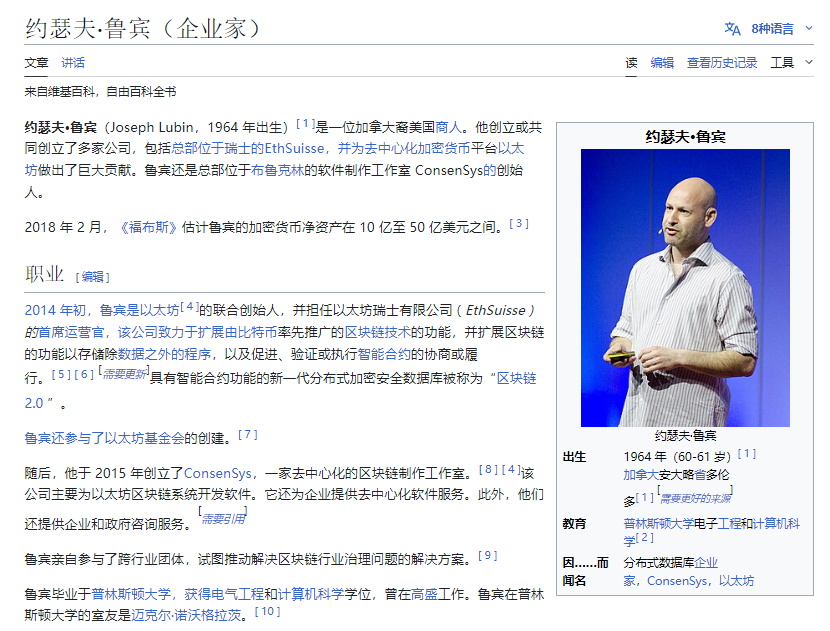
SBET's actions have drawn high market attention not by chance, but because behind it stands Joe Lubin, one of Ethereum's eight co-founders and current helmsman of blockchain infrastructure giant ConsenSys.
Lubin has developed an extremely aggressive asset accumulation strategy for SharpLink. In a Bloomberg TV interview, he bluntly explained the company's core development goals: "We firmly believe that on a fully diluted per-share basis, we will be able to accumulate Ethereum faster than any other Ethereum-based project and will inevitably lead those focused on Bitcoin." This declaration clearly positions them as an ambitious challenger in the Ethereum accumulation track.
To achieve this breakthrough development, Lubin confirmed that SharpLink is actively preparing funds through diversified capital market operations. They not only increase ETH positions daily through market trading tools but also apply advanced staking strategies to continuously release value from existing reserve assets for additional returns. This "asset appreciation + staking revenue" dual-wheel drive model aims to accelerate SBET's reserve scale and market dominance through compound effects. Lubin especially emphasized the importance of time factor in the interview: "SharpLink's core strategy can be summarized as: speed wins, surpassing all competitors' speed to accumulate critical Ethereum assets for shareholders."
Leaders' Battle: BitMine and SharpLink's Strategic Divergence and Market Competition
The core competitor currently facing Lubin's SharpLink is BitMine Immersion Tech (BMNR), chaired by famous Wall Street strategy analyst Tom Lee.

strategicethreserve data shows top 10 companies holding Ethereum
StrategicETHReserve statistics show that currently top-ranked entities are institutional fund management companies:
- BitMine Immersion Technologies (BMNR): Currently holding 566,800 ETH, market value around $2.13 billion, firmly occupying the top spot.
- SharpLink Gaming (SBET): Currently holding 360,800 ETH, corresponding value around $1.35 billion, ranking second.
- Ethereum Foundation: As a non-profit core support institution, holding 236,600 tokens.
- Ether Machine: Another active institutional Ethereum holder.
- PulseChain: A highly watched new project and treasury race competitor.
Additionally, centralized exchange Coinbase, crypto mining company Bit Digital, and the non-profit Golem Foundation dedicated to distributed computing development have also been confirmed to hold over 100,000 ETH assets, becoming important forces outside the list.
Facing the powerful BMNR, SharpLink chose a completely different growth path. Lubin clearly stated their high regard for risk management principles in the interview: "SharpLink currently does not use any form of leveraged financing in its operations." Compared to BMNR's potentially complex derivatives or lending operations, SharpLink primarily relies on equity financing or own cash flow when increasing ETH holdings. This forms a sharp contrast with MicroStrategy's typical debt expansion approach in the Bitcoin domain.
However, Rubin also revealed that SharpLink is actively exploring the possibility of expanding financing channels, particularly investigating the direction of "convertible notes" (a debt instrument that can be converted into company stock under specific conditions). MicroStrategy has repeatedly used this financial tool to successfully raise billions of dollars for large-scale BTC asset accumulation. Rubin emphasized: "Regardless of which financial tool we choose in the future, the company will implement extremely strict leverage risk control measures." He further added: "SharpLink will always maintain a cautious attitude towards various risk exposures, as we believe that a steady and sustainable operating strategy will ultimately maximize long-term shareholder interests." This stance clearly reflects SharpLink's attempt to find a precise balance between accelerated expansion and risk control, avoiding systemic risks during market volatility due to excessive leverage.
In-depth Analysis: The Logic and Market Resonance Behind the Treasury Race
Why are these institutional treasuries from the US stock market so enthusiastically competing for ETH? Their core logic far exceeds simple hoarding and contains deep strategic demands.
- Seizing the Core Digital Infrastructure Entry Point: In the evolution of Web3 technology, Ethereum, with its most extensive and mature decentralized application ecosystem, is widely viewed as the core infrastructure of the future new economy. Numerous application protocols with real user bases and economic vitality are built on the Ethereum platform. Purchasing and holding ETH is essentially a stock-like allocation of the long-term value of this core digital infrastructure, aiming to capture the dividends from network continuous growth.
- Locking Scarce Assets to Obtain Excess Returns: Unlike company stocks that can be infinitely issued, ETH's total supply is strictly limited by algorithms, with its annual issuance rate designed to be extremely low and potentially even deflationary. The large-scale and continuous purchasing behavior of these treasuries is actually accelerating the consumption of public market liquidity. This long-term reserve strategy based on hard scarce assets is viewed as an effective tool to counter potential dilution of global fiat currencies.
- Creating a Compliant Crypto Exposure Channel for Institutions: Currently, direct investment in native ETH assets still presents traditional large institutions with multi-dimensional complex challenges in regulatory compliance, custody security, and accounting treatment. These ETH treasury companies listed on NASDAQ or NYSE (such as SBET, BMNR) precisely provide an efficient alternative: institutional and individual investors only need to purchase standardized stocks to obtain the corresponding proportion of underlying Ethereum asset exposure, achieving risk isolation and compliance conversion.
Demand Explosion: Institutional FOMO Driving ETH Value Reassessment
This unprecedented institutional treasury race has already produced immediate and profound effects on Ethereum's supply and demand balance.
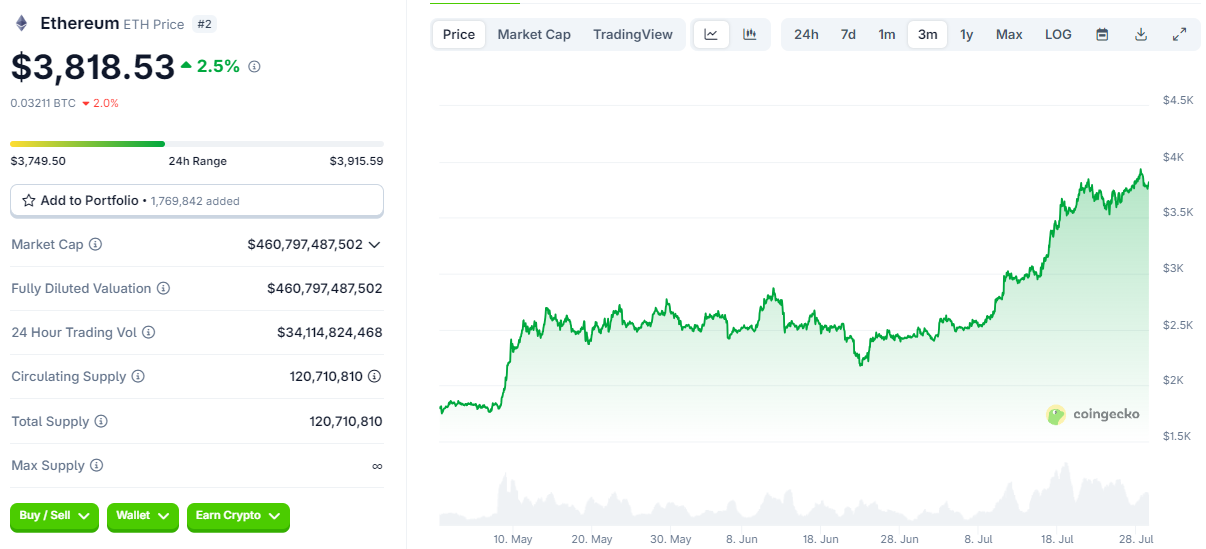
CoinGecko statistics show that ETH's value increased by 110% in just ninety days, now approaching the $3,800 mark.
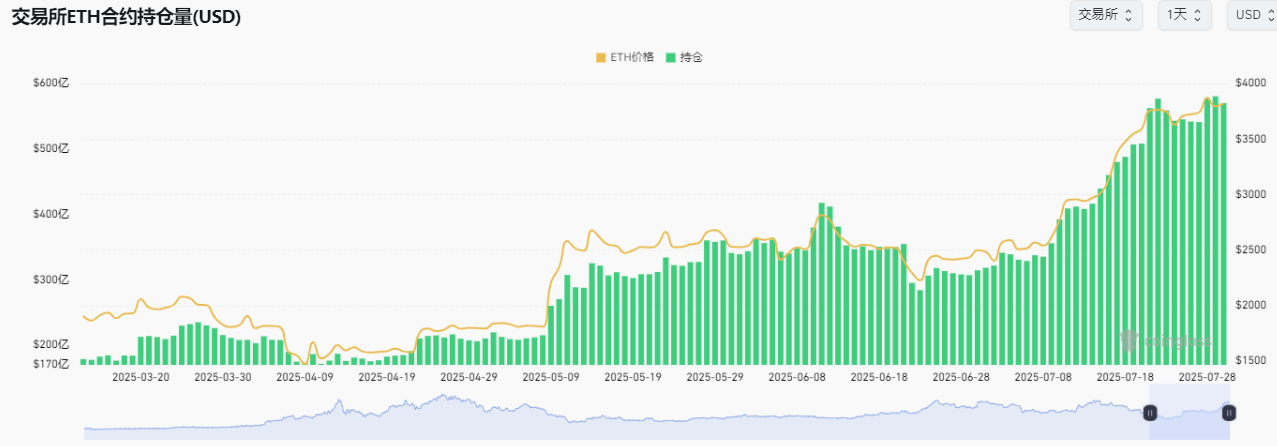
Coinglass data shows that Ethereum's contract positions surged from $17 billion to the current $58 billion during the same period.
This performance far exceeds the growth rates of many early-leading token assets like BTC and SOL during the same period.
Critically, this surge occurred against the backdrop of ETH being slightly behind in early market enthusiasm compared to other competitive public chain networks, making this strong comeback even more worthy of in-depth analysis.
The market has keenly perceived the change in capital structure: capital from professional fund managers is continuously injecting energy into ETH. Large amounts of ETH are being locked in these institutions' balance sheets as long-term strategic reserves, directly causing a rapid contraction of tradable spot ETH supply in the secondary market. This "tightening effective liquidity" combined with "institutional allocation demand expansion" forms a solid underlying logic driving ETH's systematic value reassessment. Especially when this mechanism forms a positive cycle, more value discovery will attract broader new capital attention and inflow.
Future Outlook: The Path to Digital Sovereign Debt and a New Financial Order
The Ethereum treasury race, ignited by Wall Street's precision instruments and guided by crypto's native soul, has long transcended a simple hoarding competition. It is a large-scale social experiment, a real-time broadcast about the transformation of value storage media and financial power restructuring. The path pioneered by MicroStrategy in the BTC domain is being replicated and upgraded in the Ethereum ecosystem by BMNR, SBET, and others in a more complex, intense, and Wall Street-like manner.
This is no longer a solo advance but a group army charge. The core of the experiment is how capital, this double-edged sword, dances with "scarcity" defined by blockchain code within the public market fence. It tests the limits of modern financial engineering: Can those ingenious convertible bonds, equity issuances, and market value management strategies become high-speed channels for "transporting" massive capital into the crypto world without overturning? How will the experiment's results feed back—will the soaring company stock prices validate the token's solid value, or will the token's surging ultimately raise the valuation palaces of these "Ethereum holding companies"? The ultimate judge of this experiment is time, and more importantly, the shareholders and token holders with intricate, both cooperative and competitive relationships, seeing if they can find that resonant frequency in this unique nested structure.
Ethereum's powerful aggregation capacity demonstrated at this moment is accelerating its transformation from a simple blockchain technology platform to an indispensable value base protocol in the digital economic world. The institutional treasury race is just a starting point, with its true endpoint pointing towards constructing a new value order based on global collaboration, open-source rules, and running on code. This path is destined to be full of gaming and restructuring, but it has already found a solid anchor for crypto finance in traditional capital markets, with a profound value revolution just lifting its curtain.
Regardless of anything, institutions have FOMO'd; regardless of anything, Ethereum has risen; regardless of anything, regardless of anything.






